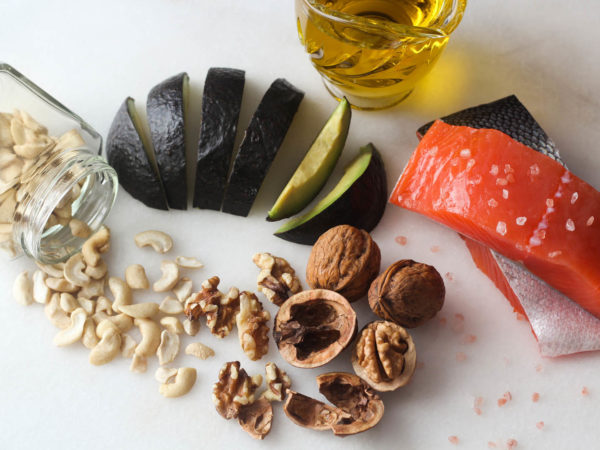In the News: Lose Weight with High Protein!

Despite what newspaper headlines and magazine covers tell you, nutrition researchers who met in New York City recently clearly do agree on the proper amounts – and best forms – of the three major food groups. On May 2, as part of the Third Annual Health and Nutrition Conference sponsored by Columbia University College of Physicians and Surgeons and the University of Arizona’s College of Medicine, Dr. Weil gave an audience of some 250 healthcare professionals a summary of the emerging consensus view on carbohydrates, fats and proteins.
Known as “macronutrients,” because they must be eaten in abundance for energy and body repair, these have become a source of confusion for the general public. “It is wrong information about macronutrients that is at the root of many of the fad and extreme diets that remain popular,” Dr. Weil said. “People attempt to lose weight by some drastic rearrangement of macronutrients.”
He emphasized that he was presenting a widely shared viewpoint on the types and quantities of these nutrients that belong in a healthy diet. Indeed, over three days of presentations by dozens of the world’s leading nutritionists at the conference, the same themes, summarized below, were sounded again and again.
Here are the guidelines as presented by Dr. Weil:
Choose carbohydrates that digest slowly. “Aim to get 40 to 50 percent of your daily calories from carbohydrates, such as whole grains, legumes, vegetables and fruits,” said Dr. Weil. Select those that convert slowly to glucose during digestion. “The single greatest change that we have wrought in the last 50 years is turning the slow-digesting food that nature produces into rapidly digesting carbohydrate foods that produce spikes in blood sugar,” Dr. Weil said. How quickly a food raises blood sugar is measured with the glycemic index, or GI. High GI foods create quick response; low GI foods convert to blood sugar slowly. Grains in their natural form have a low GI. Processed carbohydrates, including those made of flour or puffed grains, have a high GI-they send blood sugar soaring quickly; and our bodies reply with a surge of insulin to normalize blood sugar levels.
This assault from high GI foods is an underlying cause of obesity, insulin resistance, and diabetes and a contributing factor in heart disease and other chronic diseases, particularly in America, said Dr. Weil. “We have been resistant to this new view of carbohydrates,” he said. “The glycemic index has been widely accepted in other parts of the world.”
While whole foods are the best source of low GI carbs, there are many misconceptions about whole grains, said Dr. Weil. “Examples of true whole grains are wild rice, barley, quinoa, millet, wheat berries—either in their natural form or cracked into a few pieces,” he said. Products in supermarkets today that carry a “whole grain” label often contain flour made from whole grains, creating a high GI food. “When you pulverize grains into flour you are producing a starch with a large surface area that digestive enzymes can work on and quickly convert to sugar,” said Dr. Weil, adding that that’s why finely textured whole wheat bread has the same GI as white bread.
To be certain you’re eating low GI carbohydrates, cook natural grains or check the texture of the packaged foods you buy. “The requirement to chew is what distinguishes true whole grain products,” said Dr. Weil; expect to do some “real jaw work.” Natural forms of fruits and vegetables, especially roots and tubers, package moderate amounts of carbohydrate with fiber, resulting in a lower glycemic load on the body.
Enjoy the right balance of fats. Fats carry flavor and make foods satisfying, said Dr. Weil – and they’re necessary for health. As much as 30 percent of daily calories can come from fat, if it’s the right kind, he said.
Americans get far too much of the wrong kind of fat: Polyunsaturated vegetable oils. “These are not healthy for a number of reasons,” said Dr. Weil. These oils contain the omega-6 linoleic acid, which promotes inflammation in the body. While a small amount is necessary, too much linoleic acid may contribute to inflammation-based diseases in our society, such as heart disease and Alzheimer’s. Linoleic acid also counteracts the effects of the anti-inflammatory omega-3 fats, found in fish, walnuts, and freshly ground flaxseeds. “The more linoleic acid you consume, the more you blunt the beneficial effects of omega-3 fatty acids which are already extremely deficient in the North American diet. This is the most serious nutritional deficiency we have in this country,” said Dr. Weil. “The benefits from low-fat diets might primarily be from lowering the linoleic acid intake, not from lowering total fat intake.”
Your best bet: Increase your intake of omega-3’s from fish, walnuts, freshly ground flaxseeds and other sources, while reducing the amount of omega-6 fats in your diet, mostly by limiting corn, sunflower, safflower, and other nut and seed oils. These often lurk in processed foods, so read labels. Replace omega-6 oils with monounsaturated fats such as extra virgin olive oil. “Saturated fat in dairy foods does not appear to raise cardiovascular risks and may offer health benefits, so there is no reason to consume reduced-fat dairy products unless you prefer their taste,” said Dr. Weil. Of course, artificial trans-fats have no place in food and are being eliminated from many packaged food products.
Make protein easy. You need only 10 to 20 percent of calories from protein each day—a modest amount. Even though protein such as meat has high status in our society, said Dr. Weil, there’s no advantage to eating more of it. “Protein puts a great workload on the body, which the burning of fat and carbohydrate do not,” he said.
When protein makes up too much of the diet, the body will burn it for fuel, a very inefficient process that results in toxic waste products that the liver and kidneys must process. Excess protein also has a diuretic effect. “It’s well known that very high protein diets accelerate calcium loss from the body and increase the risk of osteoporosis,” said Dr. Weil. Protein foods such as meat and fish also concentrate environmental toxins.
“The less-concentrated protein in plants, such as beans, whole grains, vegetables, and fruits such as avocadoes, is the healthier choice for most of your protein needs,” said Dr. Weil. Plus, plant proteins come packaged with fiber, carbohydrates, healthful fats and phytochemicals that protect against disease.
By Kathy Kukula
DrWeil.com News









